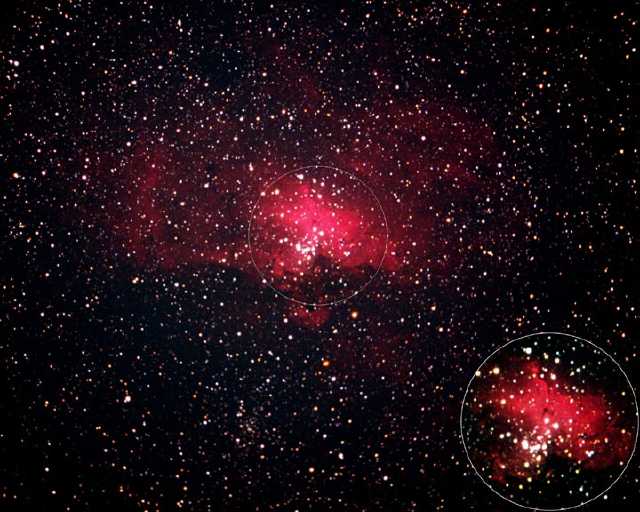Last updated: 9 August 2005
|
|
Last updated: 9 August 2005 |
Some LXD55 users have sent me examples of their astrophotography. If you have some examples you would like included here please send me a description of how you made the astrophotos and a copy of the images as GIF or JPEG files (due to internet email gateway issues, please send only one image file per message or ZIP or Stuff multiple files). Send to mweasner@optcorp.com. Alternatively, if you have created your own web page with your examples please let me know and I'll include a link to your site.
| Submitted by: Dieter.Wolf@DNSint.com [9 Aug 05] |
|---|
|
I spent a long night (fst 4m.5) in my garden on July 28th chasing late
spring globular clusters (M3, M4, M5, M13, M92).
They are bright enough for city light observatory sites. Besides M4, which
is too far down in the south, they all appear pretty much similar - about
6m visual brightness, about 15 arcminutes in diameter, partially resolved
with brightest stars about 12m.
My 'ranking' would be M13 - M3 - M5 - M92 - M4.
Here are two 'shots' of that night with LXD55 SN-10 and ToUCam SC1 at prime focus. M3, 18x15s exposures (nicely resolved to the center) |

|
| M92, 17x15s exposures (unfortunately overexposed in the center) |

|
|
Additionally I tried M27.
Although it could be nicely seen in the 24,5mm MEADE SWA ocular, it was
quite difficult to do because the low surface brightness did not fit well
to the relatively high magnification of the ToUCam CCD (hardly visible on
the LCD screen of my notebook).
M27, 40x15s exposures (had to treat it hard to bring up some contrast) |

|
| Submitted by: Peter Kennett (peterkennett@earthlink.net) [25 Jul 05] |
| This is a 30 minute deep exposure of the Lagoon Nebula in Sagittarius taken at prime focus on a LXD75 8" SN. Photographed with an Olympus OM-1 on Kodak E200 slide film. There is very little work in Photoshop... saturation was actually REDUCED! |

|
| This is a 20 minute exposure of the Trifid Nebula (M20) in Sagittarius taken at prime focus on a LXD75 8" SN. Photographed with an Olympus OM-1 on Kodak E200 slide film. |

|
| This is a 30 minute exposure of M101 Galaxy in Ursa Major taken at prime focus on a LXD75 8" SN. Photographed with an Olympus OM-1 on Fujichrome 400F Provira slide film. |

|
| This is a 40 minute deep exposure of the famous Eagle (M16) nebula taken at prime focus on an LXD75 8" SN. This exposure was extended to bring out the faint outlying nebulosity that is rarely seen in photographs. To show where the "Eagle" is located I have reduced the nebulosity in the lower insert. Photographed with an Olympus OM-1 on Kodak E200 slide film. This photo also demonstrates the exceptional wide field of view of the 8" f/4 SN. In fact, this photo was cropped 10% from the original slide! |

|
| Submitted by: Peter_Kennett@fws.gov [18 Jul 05] |
|
The camera was an Olympus OM-1, focused with a Stilletto.
I hand guided with an Orion 80mm Guide-scope. LXD75 8" SN.
I especially am impressed with the flat fields, and lack of diffraction
spikes.
Here's M-17, extended deep-sky shot, to show detail in the faint nebulosity. 45 minutes. Fujichrome 400 Provira. Uncropped. No computer processing. |

|
| Here's one of M-31. Same setup. 30 Minutes. Cropped slightly, and edited in Adobe Photoshop for Mac OSX I'll try an hour on the next clear night! |

|
| Submitted by: Dieter.Wolf@DNSint.com [18 Jul 05] |
|
I would like to post a little picture that is hardly worth posting, besides
the fact that I 'caught' it while 'scratching' along a neighboring roof
top:
M4, Globular Cluster in Scorpius, 26.5 south of the equator and thus an optimum of 15 above the horizon at my location. This very close and 'loose' GC only showed me the brightest stars and a touch of something like a central bar of stars. 2005-07-09 00:30 CEST, LXD55 SN-10 with ToUCam SC1 at prime focus, 20x20s exposures |

|
| Submitted by: Dieter.Wolf@DNSint.com [11 Jul 05] |
|
�we have NOT been blessed with clear skies in Southern Germany for the last
weeks.
And I would not have setup my scope yesterday too IF there would not have
been the chance to 'catch' my first supernova!
So I spent an hour to catch gaps between the clouds and 45 minutes of frame
grabbing to get a handfull of usable frames.
SN2005cs in M51, a type II SN, has been discovered on June 28th by a german hobby astronomer. It is nice to have this spectacular explosion - billions of times brighter than a normal star - close enough (some million ly's) to see, but far enough (at least a few thousand ly's) to not cause any damage in our own 'neighborhood'. 2005-07-06; 01:00 CEST; LXD55 SN-10 with ToUCam SC1 at prime focus; (only) 10x20s frames; SN2005sc about 14m brightness Picture1: SN2005sc in M51 (hard contrast) Picture2: compared with a pre-nova picture (April 17th) |
 
|
Go to the April-June 2005 Guest Deepsky Astrophotography Page.
Go to the January-March 2005 Guest Deepsky Astrophotography Page.
Go to the August-October 2004 Guest Deepsky Astrophotography Page.
Go to the March-May 2004 Guest Deepsky Astrophotography Page.
Go to the 2003 Guest Deepsky Astrophotography Page.
Go to back to my LXD55 Home Page.